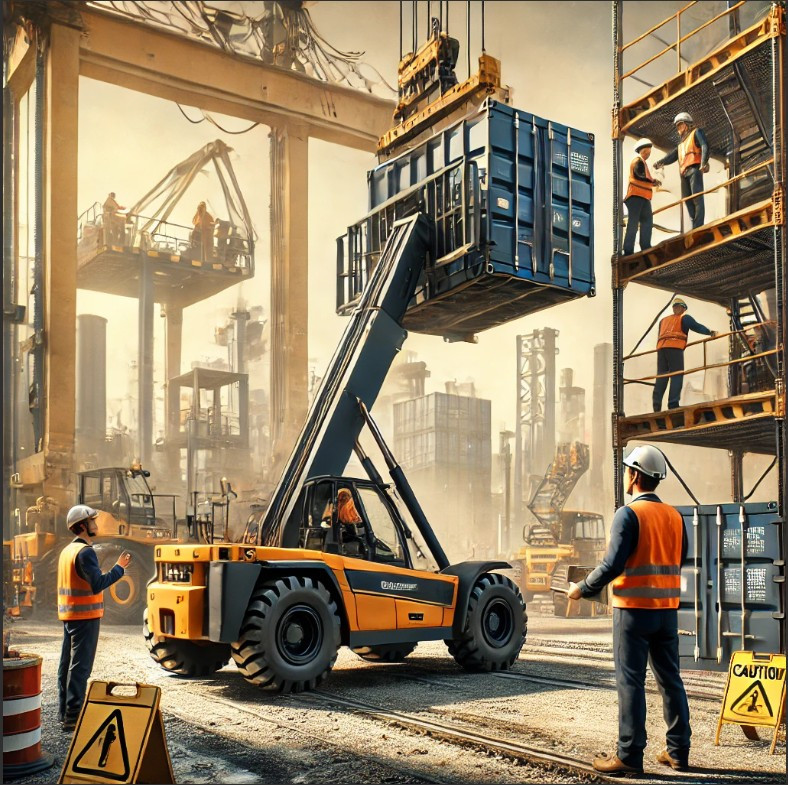Telehandlers, also known as telescopic handlers, are essential machines on construction sites, warehouses, and agricultural job sites. Their ability to lift heavy loads, extend reach, and maneuver in tight spaces makes them invaluable for improving work efficiency. However, operating a telehandler without proper training can lead to accidents, injuries, and costly downtime.
That’s why telehandler training is crucial—not just for safety but also for boosting productivity. At Get Drivers Ed, we provide comprehensive telehandler training to help workers develop the skills needed to operate safely, increase efficiency, and stay compliant with workplace regulations.
Why Telehandler Training is Essential
1. The Role of Telehandlers in Job Site Productivity
Telehandlers are versatile machines that combine the lifting power of a forklift with the reach of a crane, making them ideal for various job site applications. These include:
Transporting and lifting heavy materials
Stacking and storing pallets in warehouses
Operating on rough terrain in construction sites
Reaching elevated work areas safely
However, without proper training, operators may struggle with stability control, load balancing, and maneuvering, which can slow down operations and increase accident risks.
2. The Hidden Risks of Untrained Telehandler Operation
Operating a telehandler without certification and proper training can lead to severe safety hazards and financial losses for businesses.
Common Risks of Untrained Telehandler Use:
Tip-Overs – Overloading or improper load distribution can cause the telehandler to tip.
Collisions with Workers or Structures – Poor visibility and improper handling can lead to workplace accidents.
Equipment Damage – Misuse can result in costly repairs and downtime.
Workplace Violations – Non-compliance with OSHA safety regulations can result in hefty fines.
At Get Drivers Ed, our telehandler training courses help operators avoid these risks by teaching proper handling, load management, and workplace safety protocols.
How Telehandler Training Improves Efficiency and Safety
3. Enhancing Job Site Productivity with Skilled Operators
A well-trained telehandler operator can maximize efficiency by improving load handling, reducing delays, and preventing accidents.
How Training Improves Productivity:
Faster Load Handling – Operators learn to lift, transport, and place materials efficiently.
Improved Maneuverability – Skilled operators can navigate tight spaces and rough terrain safely.
Minimized Equipment Downtime – Fewer accidents mean less time spent on repairs and maintenance.
Better Coordination with Teams – Training ensures operators communicate effectively with ground crews.
At Get Drivers Ed, we focus on real-world applications in our training, so operators develop the skills needed for maximum efficiency.
4. Mastering Load Stability and Handling
A major component of telehandler training is learning how to safely lift and transport loads.
Key Skills Taught in Training:
Understanding Load Capacity – Preventing overloads that could tip the machine.
Proper Load Placement – Reducing risk of dropping or shifting materials.
Balance and Stability Control – Ensuring even weight distribution for safer operation.
Using Attachments Effectively – Learning how to switch and operate different forks and buckets.
With hands-on training at Get Drivers Ed, operators develop confidence in handling heavy loads with precision.
OSHA Compliance and Workplace Safety
5. Why OSHA Requires Telehandler Training
The Occupational Safety and Health Administration (OSHA) mandates that all telehandler operators must complete proper training and certification.
Reasons for OSHA Regulations:
✅ Reduces workplace accidents and injuries.
✅ Ensures workers understand machine limitations.
✅ Prevents costly fines and legal issues for employers.
✅ Improves workplace efficiency and morale.
Employers who fail to comply with OSHA regulations face severe financial penalties and an increased risk of accidents. That’s why certification from Get Drivers Ed is essential for any worker operating a telehandler.
6. What to Expect in Telehandler Certification Training
At Get Drivers Ed, we provide a structured telehandler training program that includes:
Classroom Instruction – Covering OSHA safety regulations, equipment functions, and hazard recognition.
Hands-On Training – Real-world exercises that help operators develop practical skills.
Final Certification Test – Ensuring that operators meet safety and efficiency standards.
By completing telehandler certification at Get Drivers Ed, workers gain job-ready skills while ensuring compliance with industry standards.
Conclusion: Boost Efficiency and Safety with Telehandler Training
A properly trained telehandler operator is not just safer but also more efficient. With the right skills, workers can handle materials quickly, prevent costly accidents, and comply with OSHA standards.
At Get Drivers Ed, we offer comprehensive telehandler training designed to help operators master safety, efficiency, and compliance.
Don’t wait—get certified today! Enroll in our telehandler training course at Get Drivers Ed and take your job site skills to the next level!


